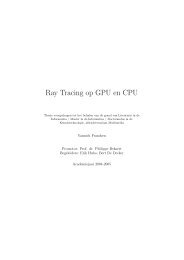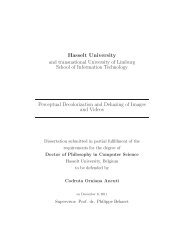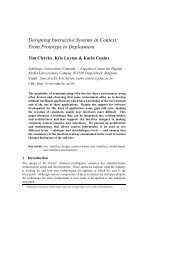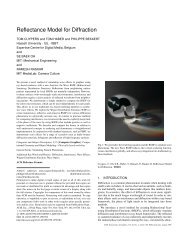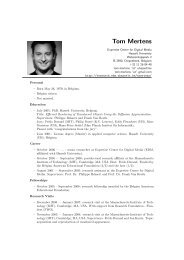DOCTORAATSPROEFSCHRIFT - EDM - UHasselt
DOCTORAATSPROEFSCHRIFT - EDM - UHasselt
DOCTORAATSPROEFSCHRIFT - EDM - UHasselt
You also want an ePaper? Increase the reach of your titles
YUMPU automatically turns print PDFs into web optimized ePapers that Google loves.
10 Outline<br />
and their lack of generality. An overview of related work concerning interaction<br />
modeling is provided in Chapter 4. Next, Chapter 5 presents the first<br />
version of the interactive object approach for NVEs, which is based on object<br />
generalization and utilizes a feature modeling approach. It is designed to<br />
support run-time adjustable interactions between all interactive objects in the<br />
virtual world by a single interaction mechanism. How interactive objects are<br />
simulated and controlled are also discussed. Finally, Chapter 6 concludes this<br />
Part with some general remarks and gives pointers to improve realism.<br />
The third Part elaborates on how our interactive object platform can be<br />
extended to support more realistic interactions. Chapter 7 explains how dynamic<br />
animations and simulations can be used to provide more realism for<br />
interactions. The related work is discussed in Chapter 8. In Chapter 9 we<br />
present ExtReAM, a new animation and simulation library that can easily be<br />
extended with new animation techniques and is easy to integrate. Chapter 10<br />
then discusses how ExtReAM is integrated in the interactive object approach,<br />
enabling new animation and simulation functionality and resulting in more<br />
realistic dynamic interactions. Our findings are given in Chapter 11.<br />
Part IV discusses the HCI part of the interaction process. Chapter 12 elaborates<br />
on the link between interaction techniques, interaction and embodiment<br />
animation. Also it discusses how more natural interaction techniques can improve<br />
the acceptance of VR for a larger audience and how it increases the user’s<br />
feeling of being immersed in the virtual world. Chapter 13 presents related<br />
work in the field of 3D interaction techniques and defines the concepts of presence<br />
and workload and describes some of the most important methodologies<br />
for measuring these. In Chapter 14 we discuss how dynamic inverse kinematic<br />
animation can support more realistic avatar interactions in virtual worlds. As<br />
we discussed earlier, dynamic animations are often avoided in NVEs since they<br />
require more networking resources than predefined animations. Therefore, we<br />
will also elaborate on how this new interaction technique can be distributed<br />
as efficiently as possible. Thereafter, in Chapter 15 we discuss how rigid-body<br />
simulation can be exploited to generate haptic feedback forces. Furthermore,<br />
we present a haptic travel method that allows users to navigate through a<br />
virtual world while receiving haptic feedback on what happens to their virtual<br />
counterpart. After presenting the technique, we evaluate the approach in a<br />
formal experiment that analyzes the influence of haptics on the user’s feeling<br />
of immersion and workload during travel in a virtual world in Chapter 16.<br />
Conclusions for this component of our research are given in Chapter 17.<br />
Part V discusses the overall conclusions of this dissertation. Furthermore,<br />
pointers for further research are given.



